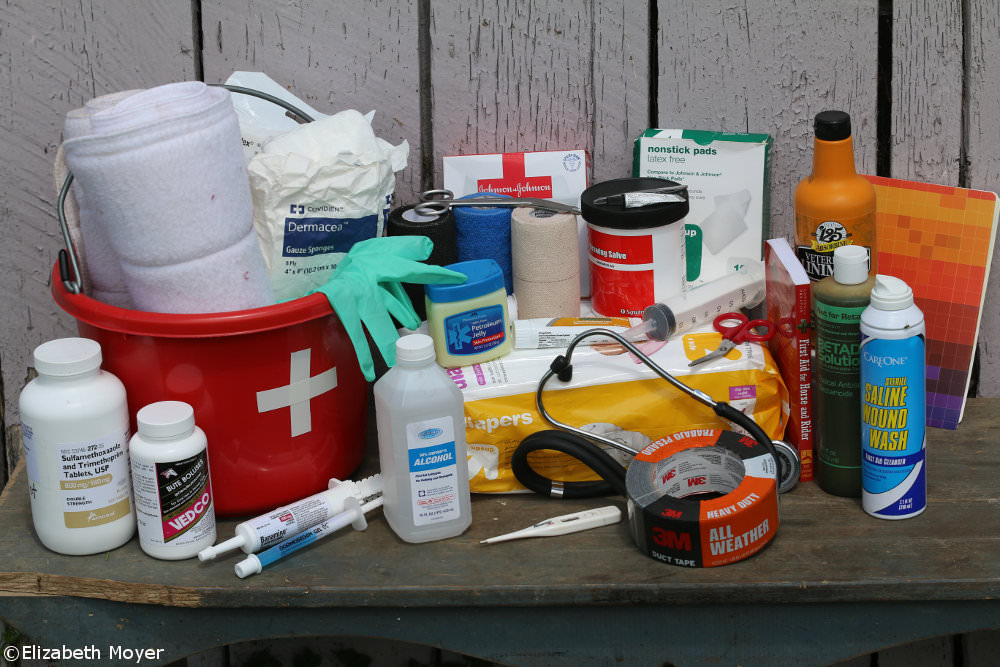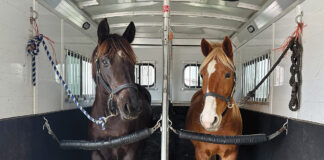It’s a beautiful day and you’re ready to take your horse for a ride. As you enter the paddock with halter in hand, you see a steady stream of blood dripping down his lower leg. Where did that come from?

Let’s look at a variety of items that you’ll want to have in a barn emergency kit that enables you to care for your horse while waiting for the vet. In all cases, be sure to store all supplies completely out of reach of children, pets and other animals, and in as temperature-controlled an environment as possible.
First-Aid Kit Basics
- A card or laminated paper with phone numbers for your veterinarian, an emergency veterinary hospital, a farrier and 911.
- Insurance company contact information if your horse is insured.
- Specific instructions regarding allowable medical care (procedures and finances you are willing to pay) if your horse is injured and you are unavailable. Also, list contact information for at least one or two other people authorized to make these kinds of decisions on behalf of your horse.
- A list of everything in your first-aid kit so you can ensure that supplies used (crossed off once removed) will be replaced.
- Pocket-sized first-aid book that covers basic horse emergencies. Be sure to learn how to take a horse’s vital signs and know what’s normal for your own horse.
- Check expiration dates on medications at least once or twice a year so you can discard as needed and replace.
- Rectal thermometer: a 5″ thermometer with a string and alligator clip to attach to the horse’s tail.
- Stethoscope: for counting heart rate and listening to intestinal sounds.
- Needles and syringes for injectable medications.
- Flashlight or head lamp with fresh batteries.
- Forceps, hemostat or tweezers to pull out splinters, cactus spines or debris.
- Multi-tool that includes wire cutters, pliers, and a rasp; the latter two tools are useful for removing a twisted, sprung or bent horseshoe.
- Lip chain or twitch: be sure you know how to use these safely and know whether your horse accepts them as restraint.

Wound and Hoof Essentials
- Resealable container: this stores many of the supplies, but can also be used as a vessel for preparing a cleansing solution by adding 1 tablespoon of salt into a liter (roughly a quart) of clean water.
- Antiseptic solution: povidone-iodine or chlorhexidine.
- Antiseptic scrub: povidone-iodine or chlorhexidine.
- Gauze squares (3″x3″) for scrubbing a wound if your horse allows it.
- Surgical gloves to prevent further wound contamination when scrubbing
the wound. - Topical antiseptic wound dressing that is water soluble, like silver sulfadiazine cream or triple antibiotic ointment, for applying to the wound to keep it protected.
- Oral antibiotics (trimethoprim-sulfa or doxycycline): at least a couple of doses to last until your vet evaluates the wound. Always consult with your veterinarian before administering.
- Diaper rash ointment (Desitin) for girth galls or overreach injuries of the heel bulbs.
- Petroleum jelly (Vaseline) to apply below a wound to limit skin scald from wound drainage, and to lubricate the end of a thermometer.
- Non-steroidal anti-inflammatory medication (phenylbutazone, flunixin meglumine, or firocoxib) to minimize or treat swelling and edema.
- Chemical ice packs that create instant cold when you pinch the catalyst.
- Fly repellent.
Bandaging Materials
- Non-stick wound dressing, like a Telfa pad.
- Bandage scissors.
- Combine pad, gamgee, sanitary napkin or disposable diaper to pad the lower leg to prevent pressure on tendons and soft tissues, or to create a hoof bandage.
- Roll or sheet cotton for padding the legs under bandage.
- Adhesive cloth tape like Elastikon or Elastoplast bandage (3-inch or 4-inch).
- Vetrap: this should only be used with sufficient padding underneath.
- Duct tape or Gorilla tape: great for wrapping a hoof. Do not use over the coronary band or any soft tissues.
- Hoof boot.
Eye Injuries
- Sterile saline eye wash solution available at the drug store for rinsing debris from the eye.
- Sterile ophthalmic ointment without corticosteroid. Until your veterinarian can confirm that there is no corneal ulceration, it is safest to use an eye ointment that contains no steroid medication in it.
- Fly mask to keep dirt, bright light, and flies from bothering an injured eye.
Colic
- Sedative, such as oral Dormosedan gel, which also acts as a painkiller.
- Flunixin meglumine (Banamine): always consult your veterinarian before administering, and for colic only administer at half of what the label recommends for lameness.
- Electrolytes to add to water if your horse will drink.
These materials in your barn emergency kit will get you through most horse crises while you await professional help. There may be other items you find important to include, so be sure to have those ready as well. Many of the supplies for your horse can also be used for human emergencies, with the exception of the oral or injectable medications.
The Bare Minimum Emergency Kit
It’s nice to have a full horse first aid kit of these items on hand in your barn or horse trailer, but when out on the trail or far from facilities, you’ll have to simply make do with the bare minimum that can be carried on your saddle. Many issues that occur off site can be temporarily patched up until you can get your horse to a barn with clean water, light, additional supplies and professional help.
- Stethoscope, or learn how to take a pulse under the jaw or back of the fetlock using your fingers and a watch that counts seconds.
- Rectal thermometer.
- Hoof boot.
- Non-stick wound dressing.
- Small tube of antiseptic ointment.
- Roll of adhesive cloth tape.
- Eye ointment without corticosteroid.
- Dormosedan gel as a sedative and pain killer to calm an anxious or
colicky horse. - Hoof pick.
- Hemostat: might come in handy to pinch off a bleeding blood vessel.
- Multi-tool.
The Value of Preparation
You may find that you’ll have everything ready at hand for a horse emergency, yet never need to dive into the first-aid kit. Wouldn’t that be great? But that’s unlikely, horses being horses, after all.
Robert Baden-Powell, founder of the Boy Scouts, proclaimed, “A Scout is never taken by surprise; he knows exactly what to do when anything unexpected happens.” This is sound preparation advice for horse owners, as well. Stocking an emergency barn kit is the first step in that direction.
This article originally appeared in the September 2017 issue of Horse Illustrated magazine. Click here to subscribe!





